This article was medically reviewed by Luba Lee, FNP-BC, MS. Luba Lee, FNP-BC is a Board-Certified Family Nurse Practitioner (FNP) and educator in Tennessee with over a decade of clinical experience. Luba has certifications in Pediatric Advanced Life Support (PALS), Emergency Medicine, Advanced Cardiac Life Support (ACLS), Team Building, and Critical Care Nursing. She received her Master of Science in Nursing (MSN) from the University of Tennessee in 2006.
There are 16 references cited in this article, which can be found at the bottom of the page.
wikiHow marks an article as reader-approved once it receives enough positive feedback. In this case, 93% of readers who voted found the article helpful, earning it our reader-approved status.
This article has been viewed 289,247 times.
The chickenpox is a common childhood disease that is highly infectious. The disease is caused by a virus called varicella zoster, which usually causes a mild and not life-threatening illness. However, the illness can be severe and possibly even fatal for some people. As an adult, you may be faced with caring for a child or another adult with the chickenpox. However, if you haven’t had the chickenpox or the vaccine, you could get the disease. Learn how to avoid getting the illness in order to reduce the chances of long-term effects that you might suffer.
Steps
Basic Precautions
-
1Understand how the chickenpox virus spreads. The virus is highly contagious and spreads in the air through particles that come from the lesions (sores) on the skin or from the upper respiratory tract. You can also get the virus if you touch the open lesions on an infected person and then touch your face, nose, or mouth.[1]
- The disease takes 10 to 21 days (15-16 days, on average) after exposure to develop.
- If you’re in close contact with someone who has chickenpox and you don’t have immunity, there’s about a 90% chance you’ll get it.
- The person with the virus is contagious from 1 to 2 days before the rash breaks out on the skin and will continue to be contagious until ALL the lesions have crusted over. This typically happens around 5 days after the rash first appears.
- Some people who get vaccinated may suffer from breakthrough varicella, which is a mild form of the chickenpox that includes a rash of less than 50 lesions and a slight fever. These individuals are also contagious. However, those with breakthrough varicella are only one third as contagious as those who were not vaccinated.
-
2Wear a mask to protect yourself from droplet transmission. Take precautions when caring for an individual with chickenpox to reduce the risk of droplet infection. Wear a facemask to prevent secretions from entering your mouth and nose. A facemask should always be worn before being in the same room with the patient and a new mask should be used each time you wear one.[2] Wear gloves, a gown, and goggles or a face mask if the individual is sneezing, coughing, or producing a lot of nasal secretions. Droplets from a sneeze can travel through the air for up to 200 feet, so it is crucial to protect yourself.[3]
- The varicella zoster virus is spread through droplet transmission or from direct contact with the individual or touching objects or clothing that were in contact with the infected individual.
- Droplets may come from a sneeze, cough, speaking, nasal secretions, and saliva.
Advertisement -
3Wash your hands before and after touching the patient. Make sure that you wash your hands before and after touching the patient or after having any contact with the objects, materials, or secretions of the patient. Use soap and warm water to wash your hands.[4]
- Lather your hands with soap and warm water for at least 20 seconds.
- Be sure to scrub the backs of your hands, between your fingers, and under your nails.
- If you need a timer for 20 seconds, hum “Happy Birthday” to yourself twice.
- Rinse your hands well under warm water and pat them dry with a clean towel or use hot air to dry them.
-
4Keep the patient in one room to prevent the virus from spreading. The patient’s bedroom is often the best room. If possible, have the patient use only one of the bathrooms in the home and be sure that no other person in the home uses that bathroom.
- Have the patient put on a mask when they leave the bedroom to go to the bathroom. Any sneezing or coughing while out of the room may also spread the virus.
-
5Use contact precautions for extra protection. Contact precautions include wearing a gown and gloves for any physical contact with the individual or other inanimate objects that may have had contact with the patient.
- When changing the bed sheets, entering the room, touching the patient, or handling any other objects, make sure that you are wearing goggles, gloves, and a gown.
Chickenpox Vaccination
-
1Get tested for immunity if you’re not sure you’ve had chickenpox. If you don’t remember whether you had the chickenpox or not, you were born after 1980, and you do not have family members who can remember, your doctor can draw a blood titer. This is a blood test that measures the antibodies in your blood for the chickenpox virus.[5]
- If you were exposed to the chickenpox and had the illness, even if it was a very mild case, then you will have antibodies in your blood that will protect you from getting it again.
-
2Talk to your doctor about whether the vaccine is safe for you. There are some people who should not have the vaccine to protect from chickenpox because of other medical issues. Discuss your medical history with your doctor to determine if you should not have the vaccine. In general, you should not get the vaccine if you:[6]
- Have had an allergic reaction to the first dose of the vaccine
- Are pregnant
- Have allergies to gelatin or neomycin
- Have an immune system disease, such as HIV/AIDS
- Have received a high dose of steroids or other medications that affect your immune system
- Are undergoing any treatments for cancer with radiation, drugs, or chemotherapy
- Have had a transfusion or received blood products within the last 5 months
-
3Ask about getting vaccinated if you’re not immune. Getting vaccinated against the chickenpox can also protect you from contracting the disease. Although most research has been done on vaccinations prior to exposure to the virus, vaccination after exposure does offer some effective protection. However, it is important to get the vaccine within 3-5 days of exposure to the illness for the best results.
- If you have not had the chickenpox nor received the vaccination, speak with your physician about being vaccinated.
- Some people who get the vaccine will get a mild case of chickenpox with fewer blisters than normal and often no fever at all.[7] The vaccine is made from live or weakened viruses.[8]
- Children get the vaccine at 12-18 months and another dose between 4 to 6 years old. The most common side effects of the vaccine are pain, redness, or swelling at the site of the injection. A small percentage of the children and adults who get the vaccine will also develop a mild rash around the spot where the shot was given.[9]
-
4Look into taking immune globulin if you can’t take the vaccine. Even if you can’t have the chickenpox vaccine because of a health problem or concern, there are still other options. Ask your doctor about getting a varicella-zoster immune globulin treatment if you think you’ve been exposed to chickenpox.[10] This treatment will help boost your immunity by giving you the antibodies you need to fight the virus.[11]
- Try to get the immune globulin treatment as soon as possible after you’ve been exposed, and don’t wait longer than 10 days after the exposure. It won’t work as well if you wait too long.
- You’ll get this medication as a shot, just like the vaccine.
- Let your doctor know if you have any serious health conditions, such as heart disease or a history of blood clots or stroke. Also tell them if you’ve recently had a vaccine, since this treatment can reduce the effectiveness of some vaccines.
-
5Discuss taking an anti-viral medication if you’re at high risk of getting very ill. If you’ve been exposed to the chickenpox virus and your doctor thinks you could get seriously ill, they might recommend a medication like acyclovir or valacyclovir. These medications could make your symptoms milder and help you recover faster. Ask about taking an antiviral medication if you’ve just started showing symptoms of chickenpox and:[12]
- You’re older than 12 years old and aren’t immune to chickenpox
- You have a chronic health problem, such as heart disease
- You’re taking steroids or salicylate medications
Risk Factors and Treatment Options
-
1Recognize the risks for specific populations of people who get the chickenpox. There are several populations of people who are at higher risk of developing significant complications that can be life threatening. These people include:[13]
- Newborns and infants whose mothers have not had the chickenpox or the vaccine
- Adults
- Pregnant women who haven’t had the chickenpox
- People whose immune systems are impaired by medications
- People taking steroids
- People with health conditions that affect their immune system, such as cancer or HIV/AIDS. People with HIV infections sometimes develop chronic chickenpox.
-
2Be aware of the potential complications associated with severe chickenpox. In some cases, the chickenpox can have serious complications that require emergency medical interventions. Complications from varicella infections include, but are not limited to:[14] [15]
- Bacterial infections of the skin or soft tissue
- Pneumonia
- Septicemia (infection in the blood)
- Toxic Shock Syndrome
- Bone infections
- Septic arthritis (joint infection)
- Encephalitis (inflammation of the brain)
- Cerebellar ataxia (inflammation of the cerebellum in the brain)
- Dehydration
- Joint infections
-
3Discuss treatment options with your doctor. Treatments for the chickenpox are usually supportive and done at home. If you are at higher risk and develop other conditions with the chickenpox, then you may need hospitalization for treatment of the secondary infection and supportive therapy. At home treatments will help the individual to recover more comfortably.[16] Common at home treatments for the chickenpox include:
- Calamine lotion and colloidal oatmeal or baking soda baths to help dry out the lesions and relieve the itching.
- Benedryl, which can help reduce itching and inflammation. For adults, the typical dose is 25-50mg 3 times a day. If you’re treating a child, ask your doctor to recommend a dose based on the child’s weight.
- Non-aspirin medications, such as acetaminophen, to relieve fever. Aspirin products can sometimes cause a severe, life-threatening reaction in children and teens called Reyes syndrome, so never give aspirin or other medications with salicylic acid to a child.
- Antiviral medications for people in a high-risk group who may develop secondary infections. Those antiviral medications include acyclovir, valacyclovir, and famciclovir.
-
4Know when to seek medical attention. If the individual is being treated at home, it is important to know what situations require immediate medical attention.[17] Call your doctor or take the individual to an emergency room if the individual:
- Is older than 12 years of age for preventative supportive care
- Has a weakened immune system
- Is pregnant
- Has a fever that lasts longer than 4 days
- Has a fever above 102 °F (39 °C)
- Has areas of the rash that become very red, warm, or tender
- Has an area that leaks thick discolored fluid
- Has difficulty waking up or appears confused
- Has difficulty walking
- Has a stiff neck
- Has frequent vomiting
- Has difficulty breathing or a severe cough
Expert Q&A
Did you know you can get expert answers for this article?
Unlock expert answers by supporting wikiHow
-
QuestionCan I continue to take my blood pressure medication if I get the chicken pox?
 Chris M. Matsko, MDDr. Chris M. Matsko is a retired physician based in Pittsburgh, Pennsylvania. With over 25 years of medical research experience, Dr. Matsko was awarded the Pittsburgh Cornell University Leadership Award for Excellence. He holds a BS in Nutritional Science from Cornell University and an MD from the Temple University School of Medicine in 2007. Dr. Matsko earned a Research Writing Certification from the American Medical Writers Association (AMWA) in 2016 and a Medical Writing & Editing Certification from the University of Chicago in 2017.
Chris M. Matsko, MDDr. Chris M. Matsko is a retired physician based in Pittsburgh, Pennsylvania. With over 25 years of medical research experience, Dr. Matsko was awarded the Pittsburgh Cornell University Leadership Award for Excellence. He holds a BS in Nutritional Science from Cornell University and an MD from the Temple University School of Medicine in 2007. Dr. Matsko earned a Research Writing Certification from the American Medical Writers Association (AMWA) in 2016 and a Medical Writing & Editing Certification from the University of Chicago in 2017.
Family Medicine Physician
-
QuestionWhat does "incubation period" mean?
 Chris M. Matsko, MDDr. Chris M. Matsko is a retired physician based in Pittsburgh, Pennsylvania. With over 25 years of medical research experience, Dr. Matsko was awarded the Pittsburgh Cornell University Leadership Award for Excellence. He holds a BS in Nutritional Science from Cornell University and an MD from the Temple University School of Medicine in 2007. Dr. Matsko earned a Research Writing Certification from the American Medical Writers Association (AMWA) in 2016 and a Medical Writing & Editing Certification from the University of Chicago in 2017.
Chris M. Matsko, MDDr. Chris M. Matsko is a retired physician based in Pittsburgh, Pennsylvania. With over 25 years of medical research experience, Dr. Matsko was awarded the Pittsburgh Cornell University Leadership Award for Excellence. He holds a BS in Nutritional Science from Cornell University and an MD from the Temple University School of Medicine in 2007. Dr. Matsko earned a Research Writing Certification from the American Medical Writers Association (AMWA) in 2016 and a Medical Writing & Editing Certification from the University of Chicago in 2017.
Family Medicine Physician
-
QuestionWhich method do I use for disinfection after chickenpox using home remedies?
 Luba Lee, FNP-BC, MSLuba Lee, FNP-BC is a Board-Certified Family Nurse Practitioner (FNP) and educator in Tennessee with over a decade of clinical experience. Luba has certifications in Pediatric Advanced Life Support (PALS), Emergency Medicine, Advanced Cardiac Life Support (ACLS), Team Building, and Critical Care Nursing. She received her Master of Science in Nursing (MSN) from the University of Tennessee in 2006.
Luba Lee, FNP-BC, MSLuba Lee, FNP-BC is a Board-Certified Family Nurse Practitioner (FNP) and educator in Tennessee with over a decade of clinical experience. Luba has certifications in Pediatric Advanced Life Support (PALS), Emergency Medicine, Advanced Cardiac Life Support (ACLS), Team Building, and Critical Care Nursing. She received her Master of Science in Nursing (MSN) from the University of Tennessee in 2006.
Board-Certified Family Nurse Practitioner
Warnings
- Never give aspirin or a salicylate medication to a child or a teen under 18 with chickenpox. In rare cases, these medications can cause a life-threatening reaction called Reyes syndrome.[19]⧼thumbs_response⧽
References
- ↑ http://www.cdc.gov/chickenpox/hcp/clinical-overview.html
- ↑ https://www.sah.org.au/assets/files/PDFs/IPC%20Fact%20Sheets/Chickenpox%20-%20revised%20Feb%202017.pdf
- ↑ http://news.mit.edu/2014/coughs-and-sneezes-float-farther-you-think
- ↑ http://www.cdc.gov/features/handwashing/
- ↑ https://medlineplus.gov/lab-tests/chickenpox-and-shingles-tests/
- ↑ https://www.cdc.gov/vaccines/vpd/varicella/public/index.html#not_vac
- ↑ http://www.cdc.gov/chickenpox/vaccination.html
- ↑ http://www.webmd.com/children/vaccines/chickenpox-varicella-vaccine
- ↑ https://www.cdc.gov/vaccines/hcp/vis/vis-statements/varicella.html
- ↑ https://www.cdc.gov/chickenpox/hcp/index.html
- ↑ https://www.mayoclinic.org/drugs-supplements/varicella-zoster-immune-globulin-intramuscular-route/description/drg-20060745
- ↑ https://www.cdc.gov/chickenpox/hcp/index.html
- ↑ https://www.mayoclinic.org/diseases-conditions/chickenpox/symptoms-causes/syc-20351282
- ↑ http://www.cdc.gov/chickenpox/hcp/clinical-overview.html
- ↑ http://www.cdc.gov/chickenpox/about/complications.html
- ↑ http://www.cdc.gov/chickenpox/hcp/index.html
- ↑ http://www.cdc.gov/chickenpox/hcp/index.html
- ↑ http://www.cdc.gov/shingles/about/transmission.html
- ↑ https://www.cdc.gov/Mmwr/preview/mmwrhtml/00001108.htm
About This Article
To avoid getting chicken pox while helping an infected person, wear a facemask to prevent droplets from their sneezing, coughing, or speaking from entering your mouth or nose, which is how the virus is spread. You should also wash your hands with soap and warm water before and after touching the patient. If possible, keep the patient confined to one room, such as their bedroom, to reduce the chance that the virus will spread. If they do need to leave their room, have the patient wear a facemask to prevent the virus from spreading to other parts of the house. For more tips from our Medical co-author, like how to get vaccinated for chicken pox, keep reading!
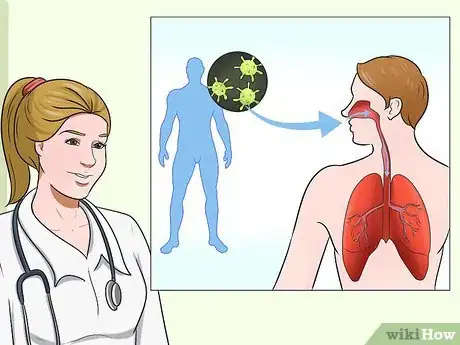

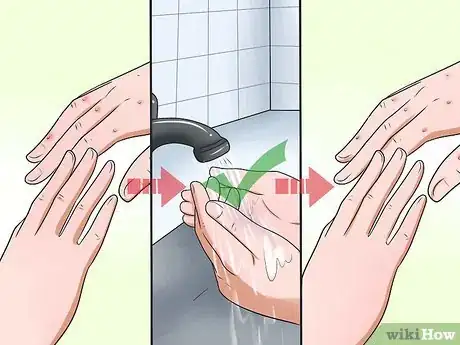
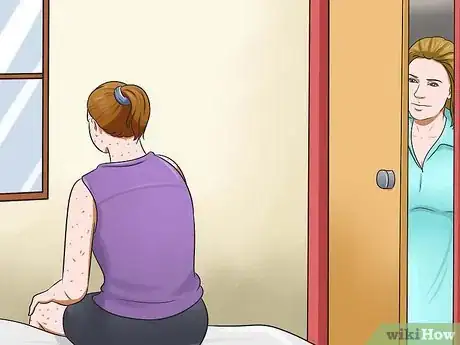
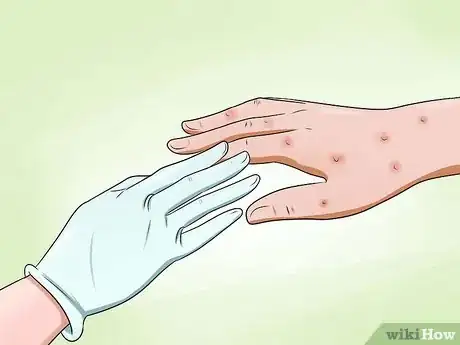
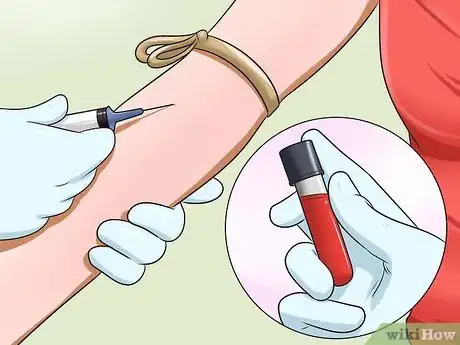
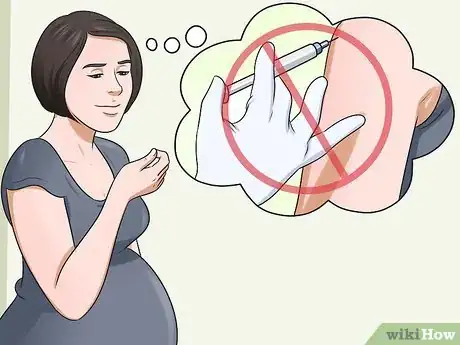
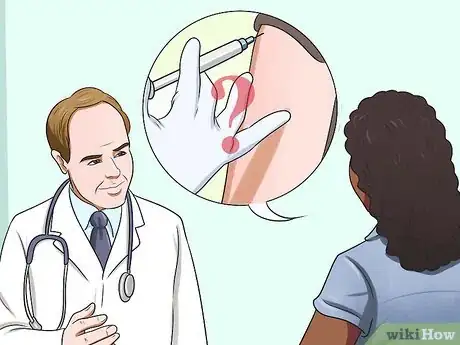
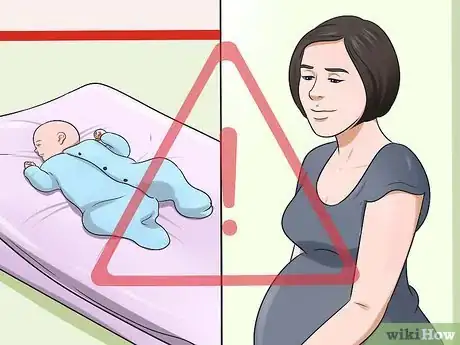

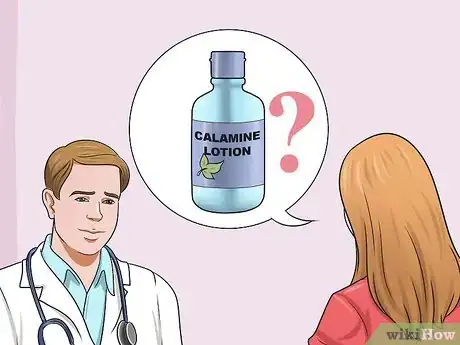
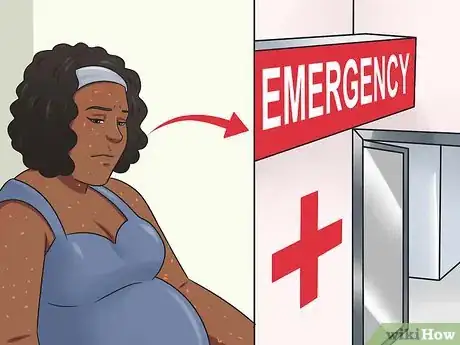
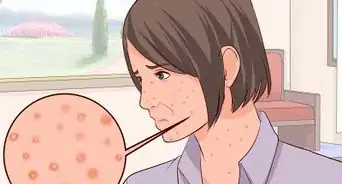
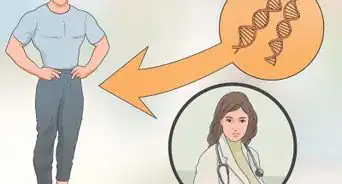

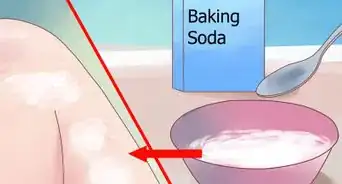

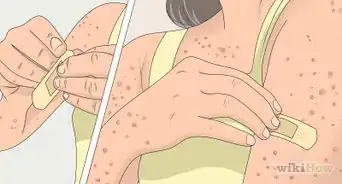
-Step-13.webp)
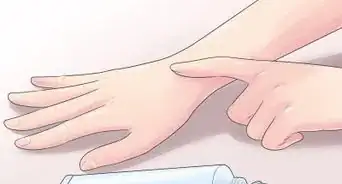
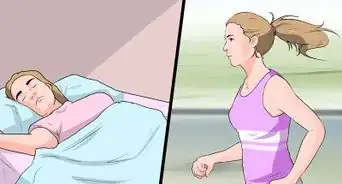
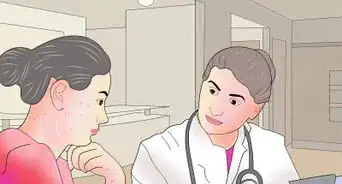
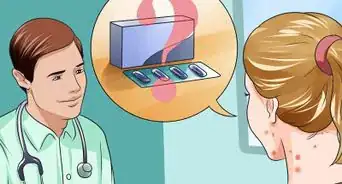










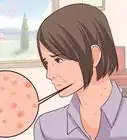

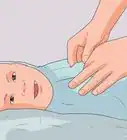
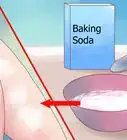



































Medical Disclaimer
The content of this article is not intended to be a substitute for professional medical advice, examination, diagnosis, or treatment. You should always contact your doctor or other qualified healthcare professional before starting, changing, or stopping any kind of health treatment.
Read More...